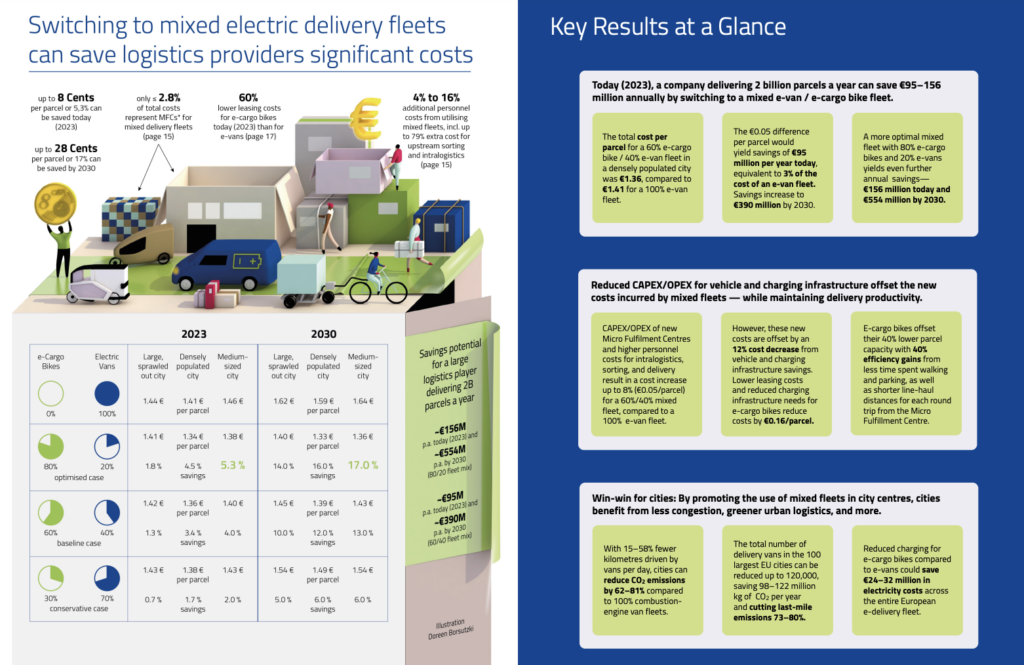Parcel delivery companies could save over half a billion euros annually using mixed electric delivery fleets in city parcel delivery, which is 5% of the delivery cost in 2023 (and 17% in 2030). A new study by EIT InnoEnergy found that mixed electric fleets of e-cargo bikes and e-vans can save urban logistics providers significant costs compared to a 100% e-van fleet operation and improve overall life quality in cities.
The study highlights the potential benefits of incorporating mixed fleets of e-vans and e-cargo bikes in last-mile logistics. It emphasizes the cost savings, spatial advantages, and environmental benefits of collaboration between various stakeholders.
The research shows for a large logistics player delivering 2 billion parcels per year with a mixed fleet of 80% e-cargo bikes and 20% e-vans (compared to 100% e-van fleet), the annual cost savings could amount to €554M by 2030, while reducing last-mile logistics emissions by up to 80%. Without intervention, projections from McKinsey indicate that this surge in parcel deliveries could add up to 40,000 vehicles to the existing fleet of over 230,000 on European city streets by 2030, further straining urban infrastructure and the environment.
The news comes as logistics companies look to improve margins and reduce CO2 emissions. E-commerce drives parcel volume in the European Union up by 8-14% each year, and regulations such as Stockholm’s upcoming inner-city ban on combustion-engine vehicles are creating pressure for logistics operators to decarbonize their last-mile delivery operations.
Given these challenges, the new study addresses an existing knowledge gap regarding the cost, operational, and sustainability impacts of adding e-cargo bikes to the mix, laying out clear comparisons between ICE van fleets, e-van fleets, and mixed fleets.
Jennifer Dungs, Global Head of Mobility at EIT InnoEnergy, says: “Logistics providers today are dealing with many simultaneous challenges: rising parcel volumes, stricter city regulations, and the need to save costs in a low-margin business. This study demonstrates that e-cargo bikes are not only a sustainable way to address these challenges, but also cost-competitive and viable for major logistics players – already today, and even more so by 2030.”

Findings showed that e-cargo bikes reduce the total cost per parcel compared to e-vans alone, regardless of the fleet mix and the city layout. In the study’s baseline case, which assumes a delivery fleet with a 60% share of e-cargo bikes and 40% e-vans operating in a large, densely populated city, the total costs per parcel in 2023 would be €0.05 lower compared to a pure e-van fleet (€1.36 vs. €1.41). By 2030, that difference on a per parcel base would increase to €0.20. For a large logistics player delivering 2 billion parcels per year, these cent amounts would translate to bottom-line annual savings of around €95M today (2023) and €390M by 2030.
In an optimized scenario (80% e-cargo bikes/20% e-vans, operating in a medium-sized city), the savings in relation to a 100% e-van fleet would be even more substantial: €0.08, or 5.3%, fewer costs per parcel today (2023) would add up to total annual savings of €156M for such large logistics provider. That cost difference per parcel would climb to €0.28, or 17.0%, by 2030, equalling total savings of €554M.
Importantly, these overall savings in all scenarios occur despite added costs incurred by mixed fleets, primarily increased personnel costs for parcel sorters at micro fulfillment centers and delivery riders.
In addition to cost savings, cities look to derive benefits from using mixed fleets. Study results indicate that introducing e-cargo bikes could reduce emissions from last-mile logistics by up to 80% across Europe’s 100 largest cities while reducing traffic congestion and competition for space by replacing up to 120,000 vans. Compared to 100% e-van fleets, the study shows that mixed fleets reduce pressure on local grids, saving the equivalent of up to 850 households’ annual energy demand per city.
The next steps for decarbonizing last-mile delivery involve collaborating with policymakers, building partner ecosystems, and optimizing resources.
- Inconsistent and divergent regulatory frameworks across cities hinder large-scale deployment of e-cargo bikes and e-vans.
- Collaboration with policymakers is crucial to address regulatory challenges and enable efficient operations.
- Building partner ecosystems and establishing shared MFCs can facilitate multi-stakeholder partnerships.
- Collaboration with municipal authorities is important to align objectives and enable the use of city space for e-cargo bikes.
- Leveraging existing hubs, such as parking spaces, can optimize resources and offer additional services.
- Data analytics should be used to optimize routing and address personnel costs, which account for a significant portion of total costs.
- Understanding the unique characteristics of each city, including delivery zones, population density, and infrastructure, is essential for developing efficient distribution systems.
Source: EIT InnoEnergy
